The AMD Ryzen 3 1300X and Ryzen 3 1200 CPU Review: Zen on a Budget
by Ian Cutress on July 27, 2017 9:30 AM EST- Posted in
- CPUs
- AMD
- Zen
- Ryzen
- Ryzen 3
- Ryzen 3 1300X
- Ryzen 3 1200
Rocket League
Hilariously simple pick-up-and-play games are great fun. I'm a massive fan of the Katamari franchise for that reason — passing start on a controller and rolling around, picking up things to get bigger, is extremely simple. Until we get a PC version of Katamari that I can benchmark, we'll focus on Rocket League.
Rocket League combines the elements of pick-up-and-play, allowing users to jump into a game with other people (or bots) to play football with cars with zero rules. The title is built on Unreal Engine 3, which is somewhat old at this point, but it allows users to run the game on super-low-end systems while still taxing the big ones. Since the release in 2015, it has sold over 5 million copies and seems to be a fixture at LANs and game shows. Users who train get very serious, playing in teams and leagues with very few settings to configure, and everyone is on the same level. Rocket League is quickly becoming one of the favored titles for e-sports tournaments, especially when e-sports contests can be viewed directly from the game interface.
Based on these factors, plus the fact that it is an extremely fun title to load and play, we set out to find the best way to benchmark it. Unfortunately for the most part automatic benchmark modes for games are few and far between. Partly because of this, but also on the basis that it is built on the Unreal 3 engine, Rocket League does not have a benchmark mode. In this case, we have to develop a consistent run and record the frame rate.
Read our initial analysis on our Rocket League benchmark on low-end graphics here.
With Rocket League, there is no benchmark mode, so we have to perform a series of automated actions, similar to a racing game having a fixed number of laps. We take the following approach: Using Fraps to record the time taken to show each frame (and the overall frame rates), we use an automation tool to set up a consistent 4v4 bot match on easy, with the system applying a series of inputs throughout the run, such as switching camera angles and driving around.
It turns out that this method is nicely indicative of a real bot match, driving up walls, boosting and even putting in the odd assist, save and/or goal, as weird as that sounds for an automated set of commands. To maintain consistency, the commands we apply are not random but time-fixed, and we also keep the map the same (Aquadome, known to be a tough map for GPUs due to water/transparency) and the car customization constant. We start recording just after a match starts, and record for 4 minutes of game time (think 5 laps of a DIRT: Rally benchmark), with average frame rates, 99th percentile and frame times all provided.
The graphics settings for Rocket League come in four broad, generic settings: Low, Medium, High and High FXAA. There are advanced settings in place for shadows and details; however, for these tests, we keep to the generic settings. For both 1920x1080 and 4K resolutions, we test at the High preset with an unlimited frame cap.
For all our results, we show the average frame rate at 1080p first. Mouse over the other graphs underneath to see 99th percentile frame rates and 'Time Under' graphs, as well as results for other resolutions. All of our benchmark results can also be found in our benchmark engine, Bench.
MSI GTX 1080 Gaming 8G Performance
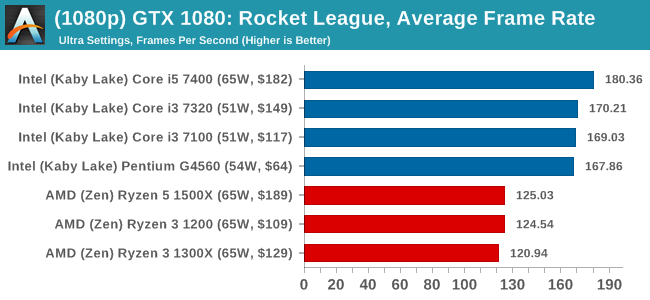
1080p



4K
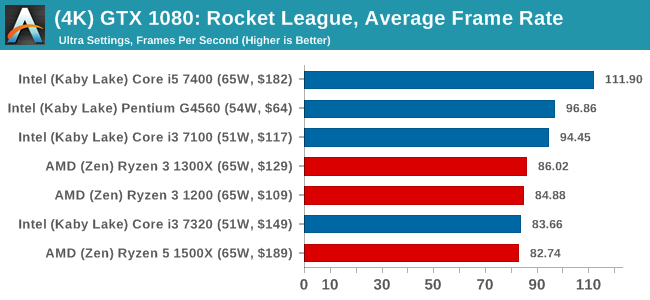
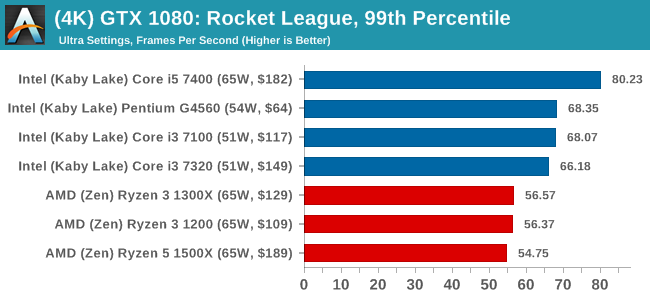
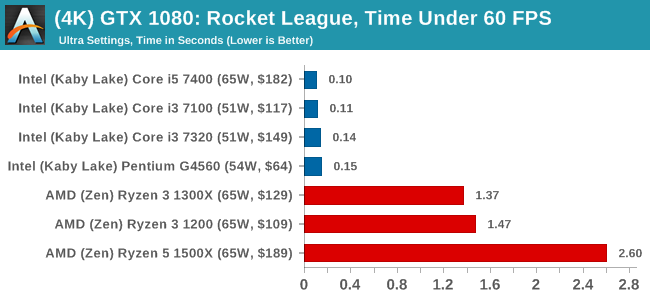
ASUS GTX 1060 Strix 6GB Performance
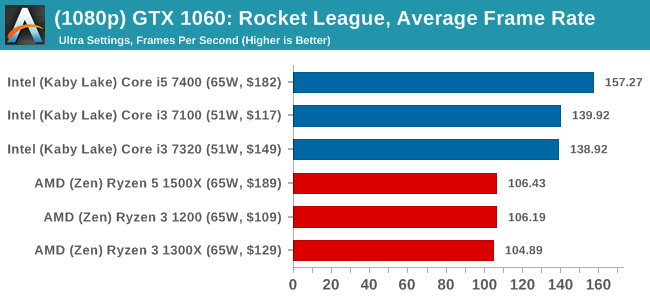
1080p


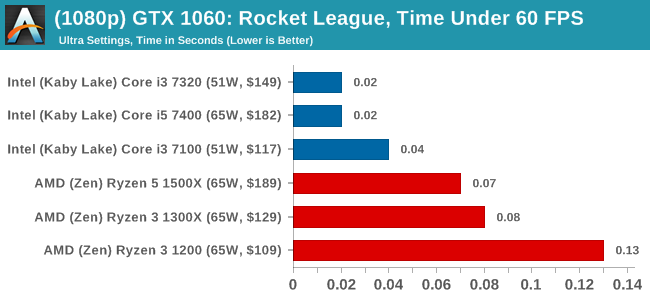
4K
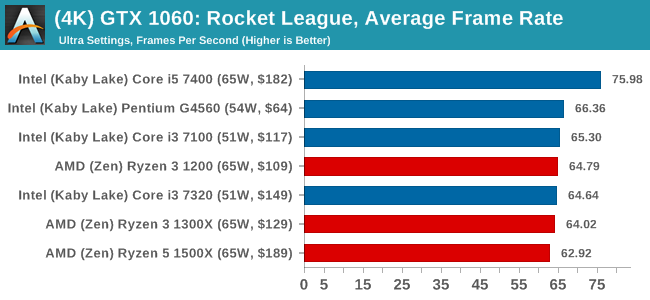
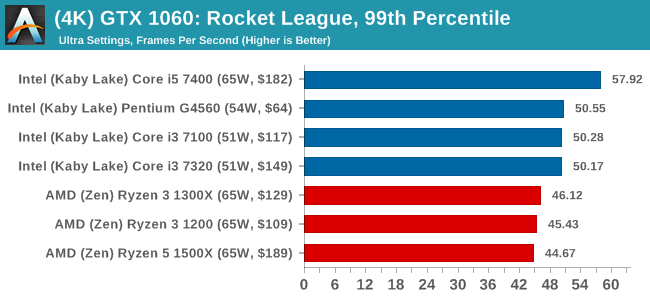
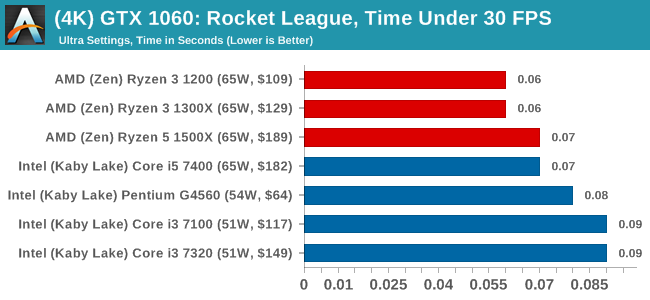
Sapphire R9 Fury 4GB Performance
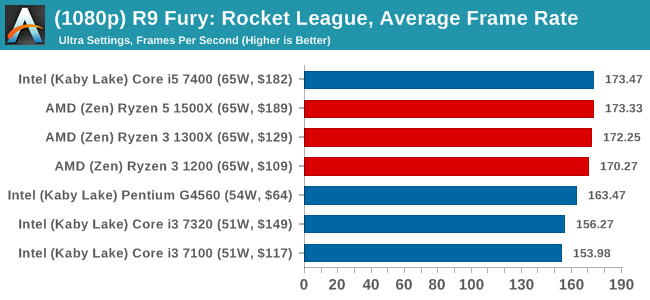
1080p


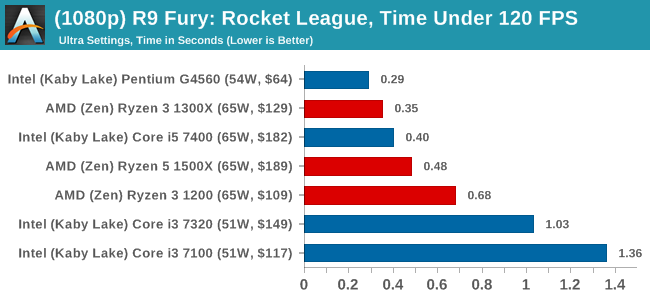
4K
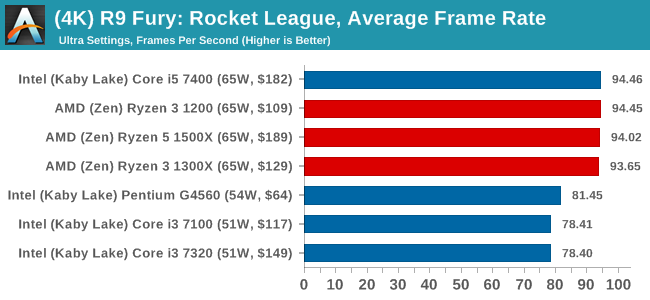

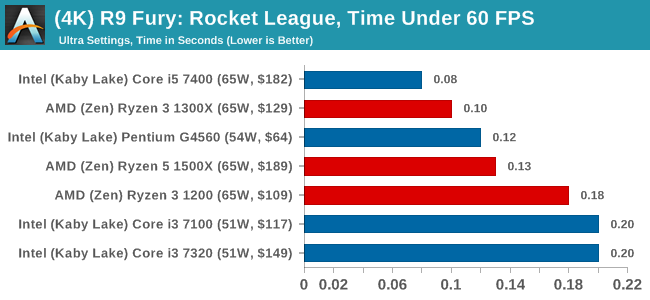
Sapphire RX 480 8GB Performance
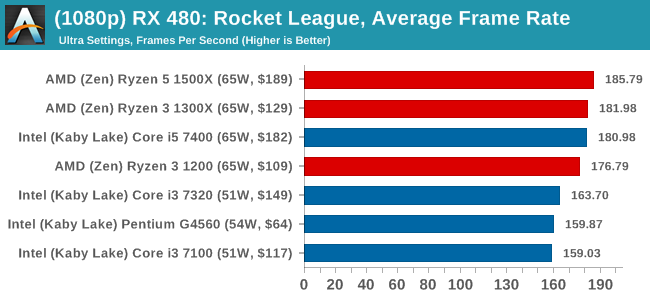
1080p

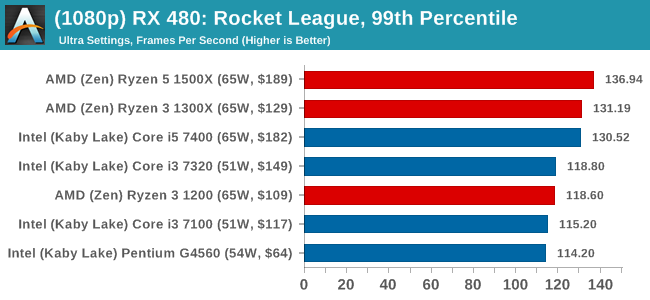
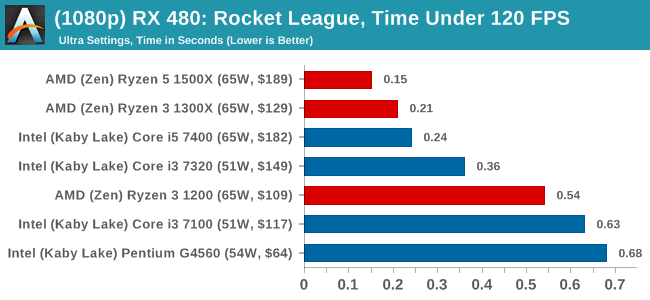
4K
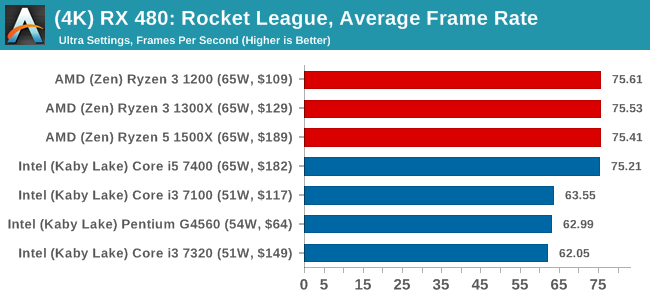
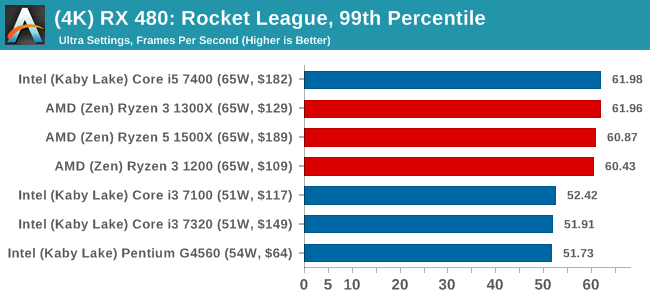
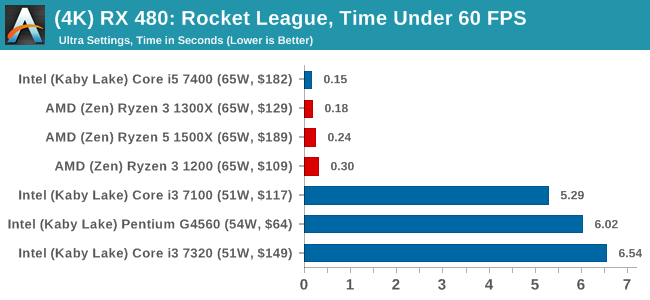
Rocket League Notes on GTX
The map we use in our testing, Aquadome, is known to be strenuous on a system, hence we see frame rates lower than what people expect for Rocket League - we're trying to cover the worst case scenario. But the results also show how AMD CPUs and NVIDIA GPUs do not seem to be playing ball with each other, which we've been told is likely related to drivers.


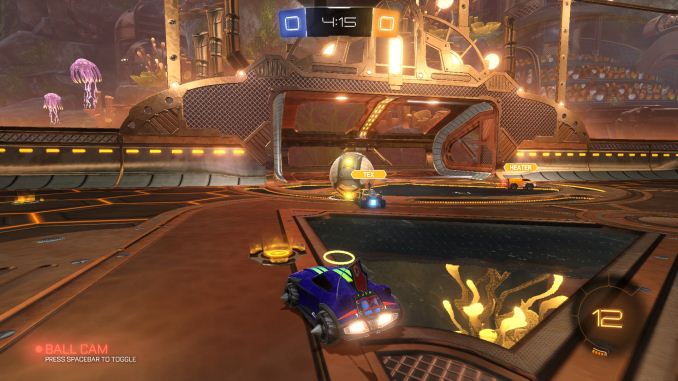
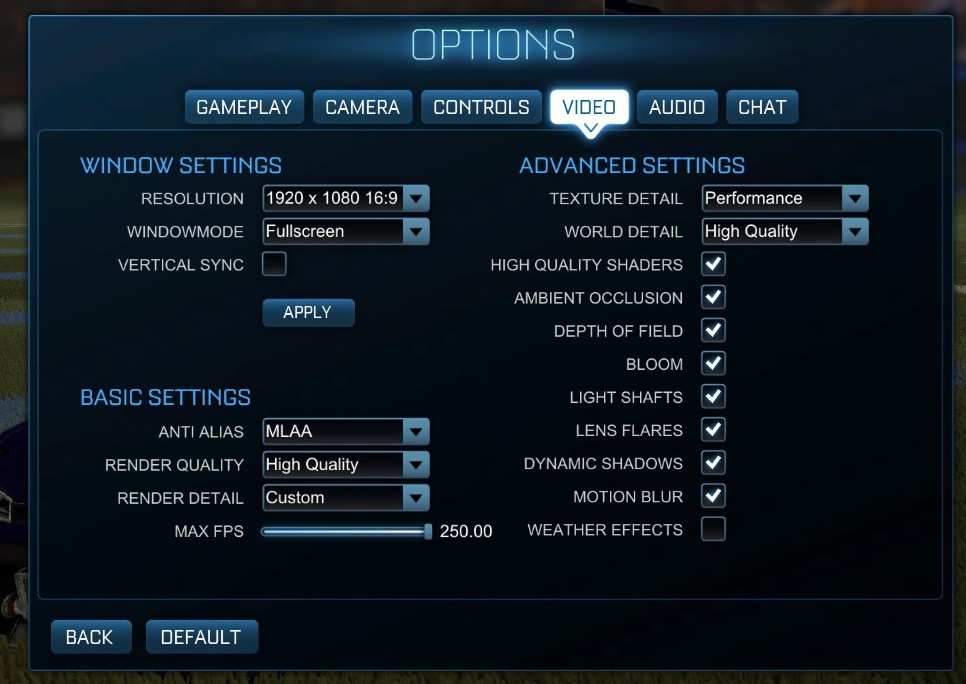








140 Comments
View All Comments
CSM 2 - Friday, July 28, 2017 - link
1200 with A320 + GTX 1050ti perfect family pc or sff media pc I'm very impressed. Thanks AMD for some competitionslickr - Sunday, July 30, 2017 - link
They actually are releasing their APU's at the same time, so if you want cpu+igp you can buy their new APU's.MajGenRelativity - Thursday, July 27, 2017 - link
Could you add an overclocking section? I've been seeing the 1200 overclock well, and that could definitely close the gap with the i3'sIan Cutress - Thursday, July 27, 2017 - link
In the plans, maybe Pt 2 next week after finishing the 1300X.T1beriu - Thursday, July 27, 2017 - link
Yey!AndrewJacksonZA - Thursday, July 27, 2017 - link
"M." You're missing an "m" at the end of your username, T1beriu. ;-)MajGenRelativity - Thursday, July 27, 2017 - link
Awesome! I think overclocking is one of Ryzen's strong points, and it doesn't seem to drive up power consumption too much, because you can hit good clocks on stock voltageOxford Guy - Thursday, July 27, 2017 - link
Or, maybe we could see what happens without being kneecapped by the absurd JEDEC RAM setting.venkatsrin - Thursday, July 27, 2017 - link
Thanks, can only second this request! Pls, pretty pls, do include the overclocked benchmarks for gaming not only with high-end cards like GTX1080 but also the RX470 that you have in there currently.QinX - Thursday, July 27, 2017 - link
The Blender graph seems to be wrong for the 1300X, beating the 1500x by 500 seconds seems excessive.